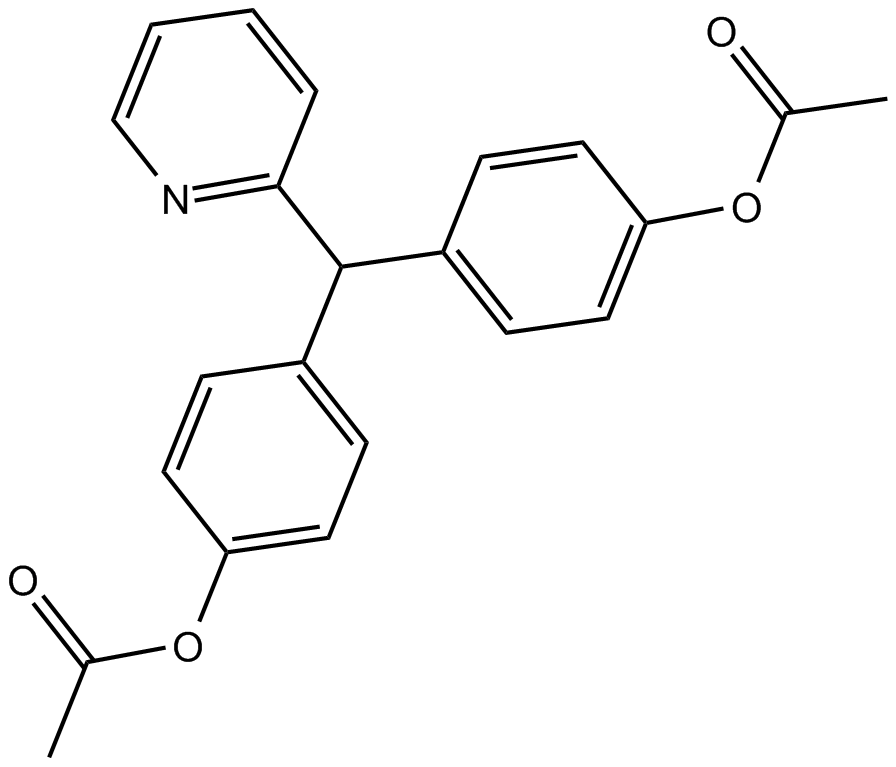Bisacodyl |
| Katalog-Nr.GC11364 |
Bisacodyl ist ein stimulierendes AbfÜhrmittel, das direkt auf den Dickdarm wirkt, um Stuhlgang zu erzeugen.
Products are for research use only. Not for human use. We do not sell to patients.

Cas No.: 603-50-9
Sample solution is provided at 25 µL, 10mM.
Bisacodyl is a stimulant laxative drug that works directly on the colon to produce a bowel movement.Target: OthersBisacodyl is an organic compound that is used as a stimulant laxative drug. Bisacodyl (20 mg/kg) results in a decrease in AQP3 protein expression and increased mRNA expression level of TNF-α in the colon of rats [1]. Bisacodyl inhibits water absorption in rat jejunum, ileum, and colon, the degree of inhibition is linearly related to the logarithm of the bisacodyl concentration over the range of 0.05 mg to 2.0 mg per 100 mL [2]. Bisacodyl (10 mg/kg, intragastrically) induces a significant decrease in jejunal NOS activity in rats. Bisacodyl (10 mg/kg, intragastrically) increases the distance traveled by the marker in all time periods [3]. Bisacodyl (5.9 mg/kg) decreases significantly jejunal and colonic (Na + K) ATPase activity as compared to saline-treated rats. Bisacodyl (5.9 mg/kg) increases significantly jejunal and colonic PGE2 content and stimulates jejunal and colonic adenyl cyclase activity as compared to those in control rats without affecting cAMP content [4]. Bisacodyl (4.3 mg/kg) coupled with AOM increases the number of crypt per focus, but not the number of tumors in rats. Bisacodyl (43 mg/kg) significantly increases the number of crypt per focus and tumors in rats [5].
References:
[1]. Ikarashi, N., et al., The laxative effect of bisacodyl is attributable to decreased aquaporin-3 expression in the colon induced by increased PGE2 secretion from macrophages. Am J Physiol Gastrointest Liver Physiol, 2011. 301(5): p. G887-95.
[2]. Saunders, D.R., et al., Effect of bisacodyl on the structure and function of rodent and human intestine. Gastroenterology, 1977. 72(5 Pt 1): p. 849-56.
[3]. Karmeli, F., R. Stalnikowicz, and D. Rachmilewitz, Effect of colchicine and bisacodyl on rat intestinal transit and nitric oxide synthase activity. Scand J Gastroenterol, 1997. 32(8): p. 791-6.
[4]. Rachmilewitz, D., F. Karmeli, and E. Okon, Effects of bisacodyl on cAMP and prostaglandin E2 contents, (Na + K) ATPase, adenyl cyclase, and phosphodiesterase activities of rat intestine. Dig Dis Sci, 1980. 25(8): p. 602-8.
[5]. Borrelli, F., et al., Effect of bisacodyl and cascara on growth of aberrant crypt foci and malignant tumors in the rat colon. Life Sci, 2001. 69(16): p. 1871-7.
Average Rating: 5 (Based on Reviews and 1 reference(s) in Google Scholar.)
GLPBIO products are for RESEARCH USE ONLY. Please make sure your review or question is research based.
Required fields are marked with *




















